-
 szardosszemagad
150Wrong. There are causes but constraints, choices and novelty make the world probabilistic. — Rich
szardosszemagad
150Wrong. There are causes but constraints, choices and novelty make the world probabilistic. — Rich
Human knowledge of the future states of the world is probabilistic. But the world itself, its future states, is determined by its past, via a chain of causality. -
 Rich
3.2kI challenge you to name one, just one rule of QM which is well-known in the public's awareness, and shows that its process is not causal. Thanks. — szardosszemagad
Rich
3.2kI challenge you to name one, just one rule of QM which is well-known in the public's awareness, and shows that its process is not causal. Thanks. — szardosszemagad
What the heck? There is nothing in QM that is causal. Bohm's interpretation is causal but non-deterministic. -
 szardosszemagad
150What the heck? There is nothing in QM that is causal. Bohm's interpretation is causal but non-deterministic. — Rich
szardosszemagad
150What the heck? There is nothing in QM that is causal. Bohm's interpretation is causal but non-deterministic. — Rich
That may be your own personal interpretation, but your opinion is false. -
 Rich
3.2kJust one more time and that will be it. Causal has nothing to do with determinism.
Rich
3.2kJust one more time and that will be it. Causal has nothing to do with determinism.
It is simple to adopt a deterministic view of the universe. All one has to do is ignore that s/he is adopting it. -
 szardosszemagad
150Rich, you do not understand logic. Causality and determinism go hand-in-hand. If you can't accept that, I can accept your inability to do so. That's the best I can offer to you.
szardosszemagad
150Rich, you do not understand logic. Causality and determinism go hand-in-hand. If you can't accept that, I can accept your inability to do so. That's the best I can offer to you. -
 Rich
3.2kWho cares about that mundane game of logic taught in academia. It is a parlor game that is easy to teach and can consume lots of credits.
Rich
3.2kWho cares about that mundane game of logic taught in academia. It is a parlor game that is easy to teach and can consume lots of credits. -
 Rich
3.2kThat may be your own personal interpretation, but your opinion is false. — szardosszemagad
Rich
3.2kThat may be your own personal interpretation, but your opinion is false. — szardosszemagad
I have no interpretation. There is zero determinism in QM. Never was and, as far as all evidence to date, never will be. Probabilistic behavior is baked into the universe as is the probabilistic wave. However, anyone is free to have faith that this may someday change as others have faith in the Second Coming. It is human nature to have faith. -
 Hachem
384Interference and Newton Rings
Hachem
384Interference and Newton Rings
Allow me to start with an image already displayed, an open camera body, no lens, and a laser pen directed at the center, more or less, of the mirror.
The first picture has been taken at 1/400s. All images were set at ISO 100.

You will notice the bright and dark circles that appear in all experiments where interference phenomena are said to be studied.
This picture has been taken, allow me to emphasize this fundamental fact, with nothing between the camera and the laser beam. Since the mirror is drawn up at the moment of exposure, these rings have to come either from the pen itself, the sensor diodes, or both.
The following pictures have been taken with an Anti Newton glass, one part of a slide frame, taped to a body cap on which a hole with a diameter of approximately one centimeter had been drilled. Notice that the so-called Newton rings are still present, but only visible at short exposures
At 1s, no rings are visible.

At 1/1000s, the rings are clearly visible.
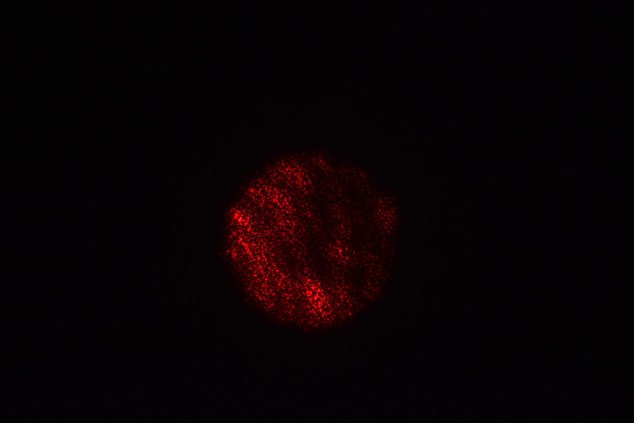
The following picture has been taken again with an anti Newton glass taped to a body cap, but this time I had made the opening much larger to avoid any misunderstandings concerning diffraction phenomena.
The lower dark half is an artifact due to misalignment of the slide. The exposure time was 1/4000s.

I thought these pictures might be interesting for people familiar with the phenomena of constructive and destructive interference, as well as with the so-called Newton rings. I wonder what they make out of it. -
 Hachem
384Interference and Newton Rings (2): double anti-Newton glass
Hachem
384Interference and Newton Rings (2): double anti-Newton glass
Since Newton rings are always presented as being the result of at least two surfaces pressed against each other, creating minuscule differences in the distances between one surface and the other, and therefore creating the rings of constructive and destructive interference, I wondered what would happen if I used both glasses of the slide, and not only one. Would the rings disappear entirely?
Apparently not.
The first picture has been taken at 1/4000s, and the second at 1/320s. The rings are definitely less pronounced as before, but still there. Would better quality glass eliminate the rings completely?
But why are they present in the first place when only one glass is used?
Again, a puzzle for whomever believes in interference phenomena.
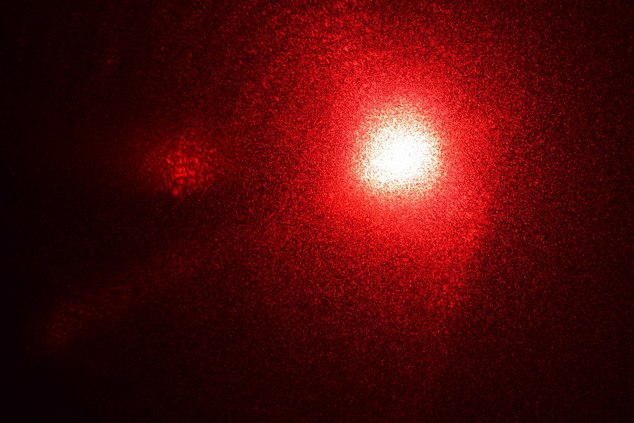
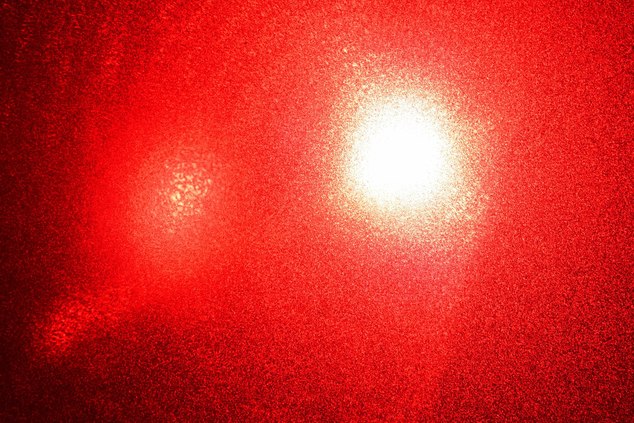
-
 Hachem
384White Light and Interference
Hachem
384White Light and Interference
I find the following picture quite intriguing, especially when you consider how the camera reacted. Instead of a laser pen I used a flash light and directed the beam, as before, through the opening of the camera body. When I looked at the Lcd screen I saw white and black bands scrolling down, in a regular fashion.
Imagine black bands like this one being alternated with white ones. It was taken with 1/1000s.
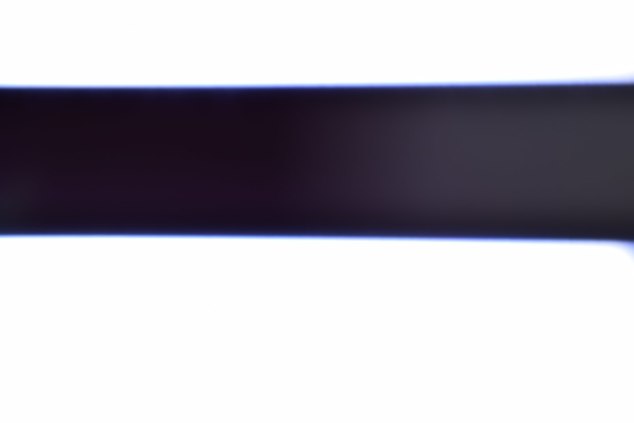
I found the scrolling very peculiar and have no explanation for it.
In fact I was trying to show the pattern my electric torch left on the wall, or a screen. A rectangular pattern of bright and dark bands. Maybe this image is just a part of it.
Anyway, I think that, just like when taking a picture of the sun, we have to adjust our exposure speed to get the sun in the picture, instead of an all encompassing white blob.
What we are seeing each time are not the light rays, but the structure behind them. -
 Hachem
384White Light and Interference (2)
Hachem
384White Light and Interference (2)
This is how the same picture looks like when a red (dark orange) filter is placed in front of the torch.
Except for the color, nothing is changed as far as I can see.
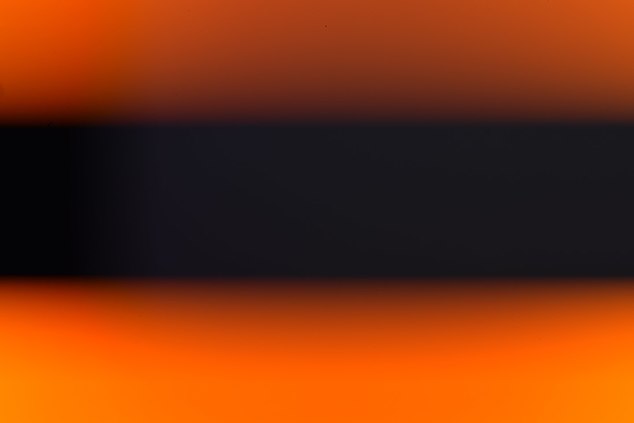
This reinforces me in my conviction that what we consider as properties of light are most often simply the properties of the light source. -
 Hachem
384Finally! The Real Double Slit Experiment!
Hachem
384Finally! The Real Double Slit Experiment!
I am sorry it took so long, but I just got the slide in the mail this afternoon. It concerns a slide (50mm/50mm) with two slits of 0,013 mm each, separated by a distance, from center to center, of 0,1 mm.
As usual, I taped the slide to the body cap of a digital camera. The cap was almost completely open, having kept only the outer periphery to attach it to the camera body.
I will let you draw your own conclusions but it seems to me that what we are dealing with is simply a slice of the image we got when nothing was impeding the laser beam on its way to the camera.
In other words, the concepts of constructive and destructive interference are completely superfluous!
1/4000s
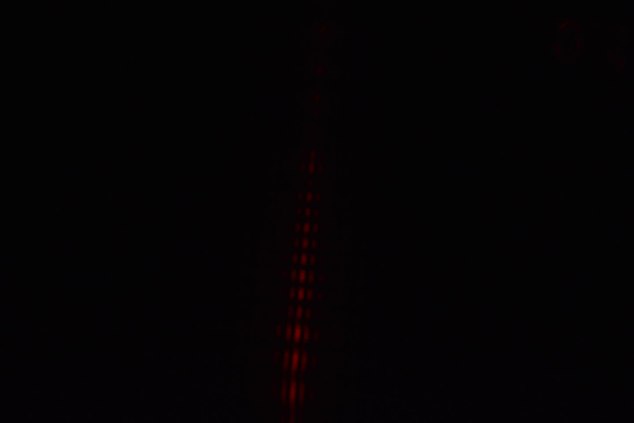
1/2000s
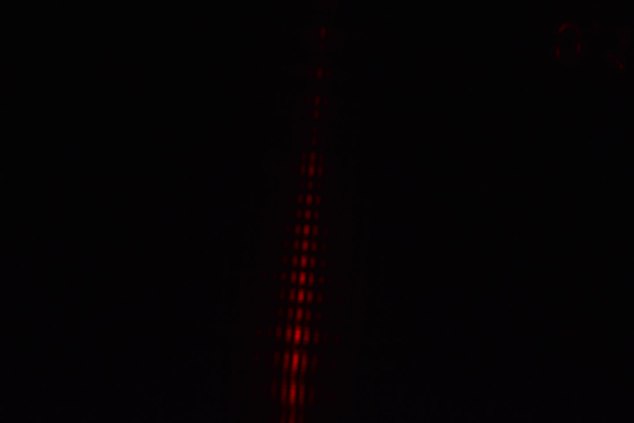
1/1000s
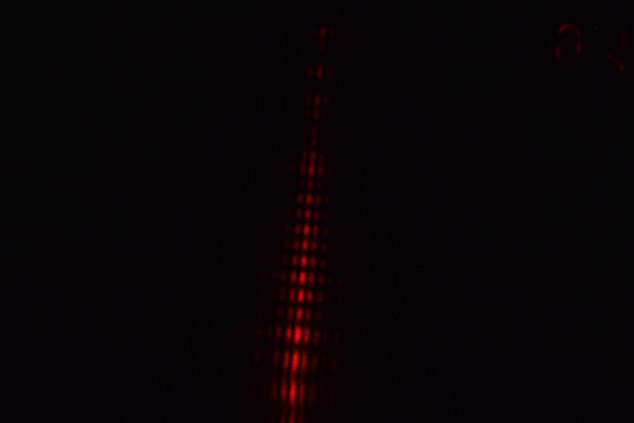
1/200s
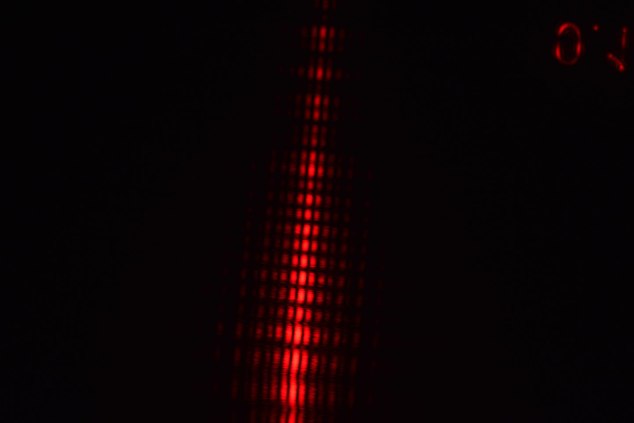
1/60s
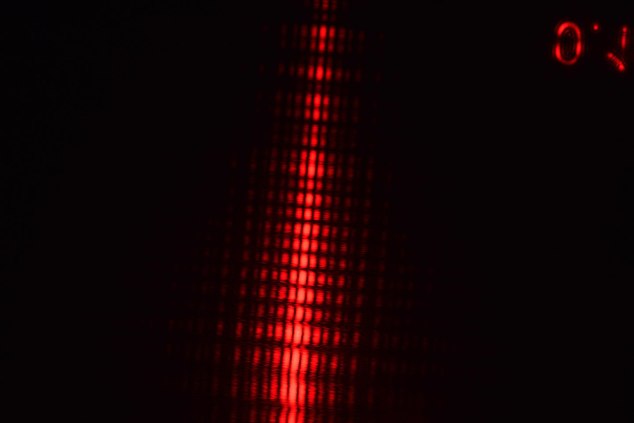
1/15s

1 second.
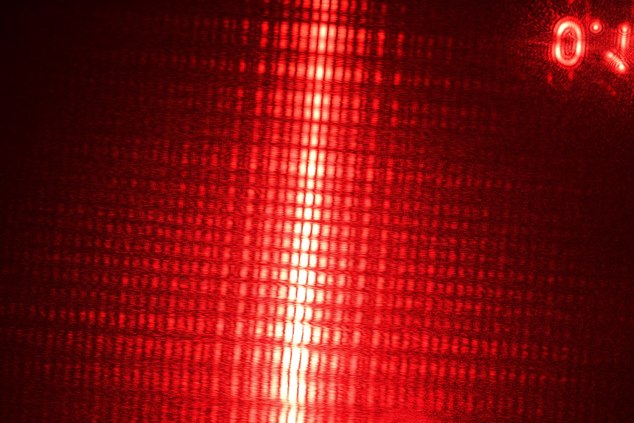
3 seconds
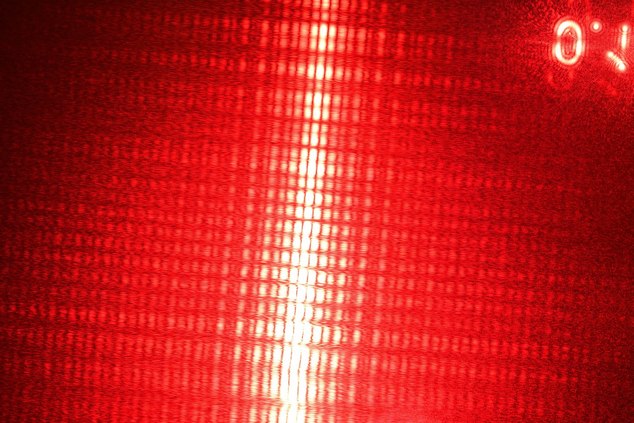
The partial text on the upper right corner are some markings on the slide and irrelevant to the double slit experiment. -
 Hachem
384Vertical Slice
Hachem
384Vertical Slice
I have used a simple application any Windows user have at his/her disposition, Paint. What I have done is take one of the pictures of the rings formed by a laser beam om the camera sensor, and deleted everything but a very thin slice.
I hope to show that the so called double split patterns of constructive and destructive interference are nothing but the original image seen through very narrow slits.
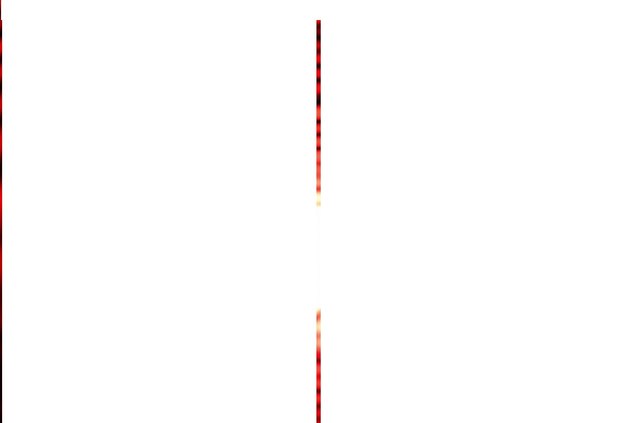
-
 Hachem
384Wave length, Distance and Interference
Hachem
384Wave length, Distance and Interference
The principle of interference, and wave length, depends on the actual distance a wave or a ray is supposed to travel between two points.
A simple way of altering the distance between two points is to rotate the screen slightly around its vertical axis. This way, some distances would become (slightly) shorter, while others would become longer.
By subtly changing the position of the screen, one should therefore be able to transform a dark ring in a bright one, and vice versa.
Shaoul Ezekiel seems to be doing just that. Except that his setup is much more complex and involves mirrors, lenses and beam splitters.
The setup with a light source and a screen is much simpler and easier to interpret: does distance play a role in the formation of dark and bright rings?
I invite you to see it for yourself. I cannot show it to you because it would need more a video feed than still images, but I personally could not detect any effect.
Please do not take me at my word! -
 Hachem
384A Real Life Approach
Hachem
384A Real Life Approach
Double slit experiments are usually presented in a very abstract manner. The light source must be monochromatic, and it is at the same time the sole object present in the experiment.
I present here pictures taken with a zoom lens, the first one free, and then with the same double slit slide I used before, taped to the lens, directly on a UV filter to avoid damaging the pricey glass.
The first pictures show in fact a double image which may be confusing. I could have just covered the letters on the slide (I think they represent the width of the slits, 0.013, but I am not quite sure), like I did for the last slides.
Notice that instead of interference patterns that always seem to be present when slits (single, double or multiple) are used, what we see is a picture, rather unsharp, representing a very recognizable part of the scene first taken with the uncovered zoom lens.
There doe not seem to be any mysterious or magical processes behind the obtained results. They are what we would see it we could look through the slits with our own eyes.
Unhindered view of one of my bookshelves. f/5.6, 1/20s, @ 92mm and ISO 100
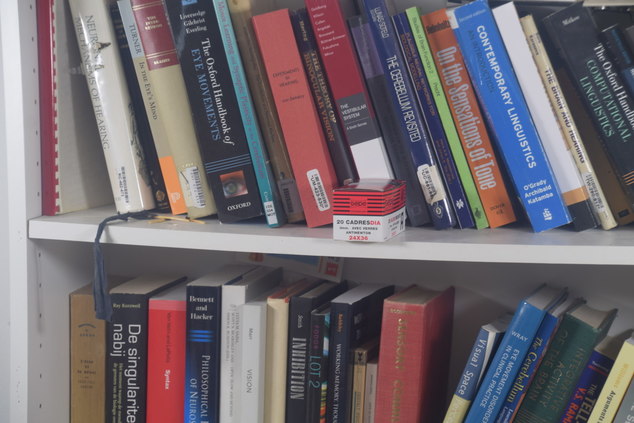
The circle represents the text on the slide. Notice that the space between the slits does not appear on the image at all. Such a phenomenon was one of the main reasons Newton's corpuscular theory was abandoned. Exposure time 15seconds.
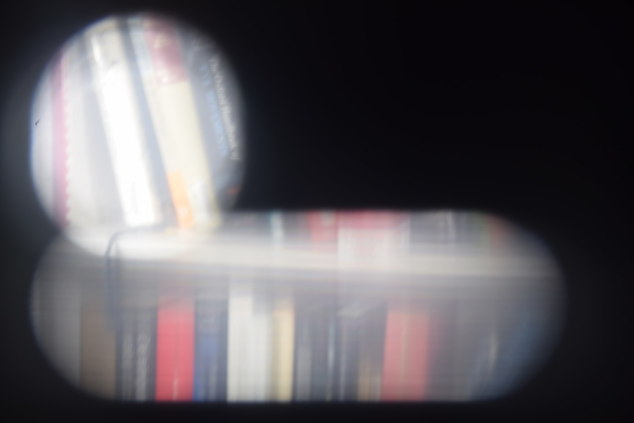
The circle has been covered by dark tape. 10 seconds.
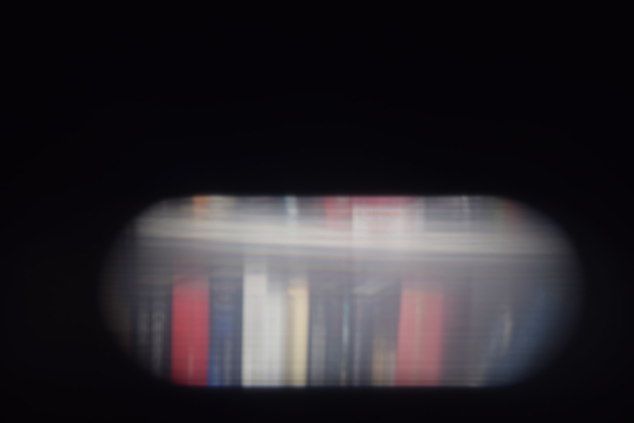
even under relatively very short exposure times, the whole scene
is still visible. 1/3 of a second.
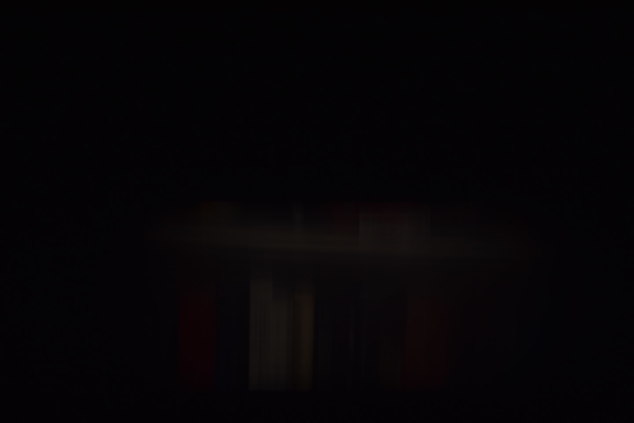
-
 Hachem
384A Real Life Approach (2)
Hachem
384A Real Life Approach (2)
There is something very interesting in the preceding, but also in the following images. Objects seem to react differently from light beams.
Look at how the laser beam is apparently reproduced over and over again.
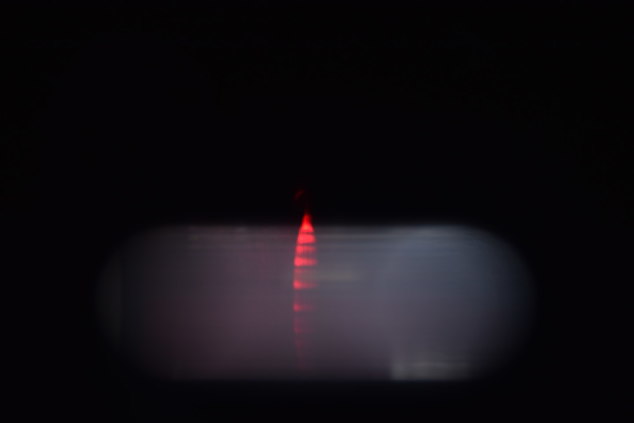
The books, on the other hand, are shown only once. The board dividing the two shelves, and which should probably be hidden by the space between the slits, seems to be projected two or three times.
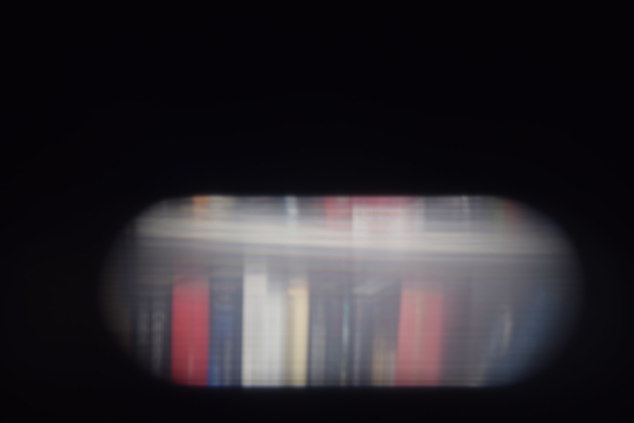
What I think is happening is that the laser beam, just like the books, also is reproduced but once. With maybe unsharp features here or there because of the divide.
I will certainly not claim of being able to explain all the features present in those images. -
 bill harris
12We now know from cosmology that the primordial state of energy is a wave-- as expressed in Quantum Field Theory. Therefore, the problem becomes, how are energy waves quantitized? From this, we can look at the double slit and ask, under what conditions have our experiments given us particular results? Now this, of course, is not a philosophical problem, but rather one of mechanical cause whose solutions will be found within the context of the science itself...
bill harris
12We now know from cosmology that the primordial state of energy is a wave-- as expressed in Quantum Field Theory. Therefore, the problem becomes, how are energy waves quantitized? From this, we can look at the double slit and ask, under what conditions have our experiments given us particular results? Now this, of course, is not a philosophical problem, but rather one of mechanical cause whose solutions will be found within the context of the science itself... -
 Hachem
384We now know from cosmology — bill harris
Hachem
384We now know from cosmology — bill harris
That is the whole issue right here. Cosmology is metaphysics for scientists.
But then again, another general objection, a show of loyalty and no attempt to look at the issues themselves. I understand if you feel you have nothing to say on these problems, but please do not then decide for others what the nature of these problems is.
,Now this, of course, is not a philosophical problem, but rather one of mechanical cause whose solutions will be found within the context of the science itself... — bill harris
Einstein and Bohr had to change their view of reality, space and time. And not (only) in a technical way. -
 bill harris
12No cosmology is the new name for 'astrophysics'--which is as real a science as there is. Moreover, i'm saying that the philosophical issue is phony (filosofikal) and founded upon an ignorance of what the particular science studies and can say. So yes, i'm deciding for others that talking filosofikally about an issue internal to scientific research is, at best, a waste of time; at worse, it gives bullshit a bad name. Otherwise, i have no ideas as to what you mean by Bohr and Einstein changing their view of reality. Newsflash: the GRT equation is pretty much in your face that spacetime s the outcome of the bending of the gravitational force (left side) by an object (rt side). In Bohr vs Einstein the former was correct in stating that The schrodinger gives a complete explanation --ie entanglement--as proven by aspect & Cie. Otherwise, perhaps one might note that filosofy is for the math-challenged?
bill harris
12No cosmology is the new name for 'astrophysics'--which is as real a science as there is. Moreover, i'm saying that the philosophical issue is phony (filosofikal) and founded upon an ignorance of what the particular science studies and can say. So yes, i'm deciding for others that talking filosofikally about an issue internal to scientific research is, at best, a waste of time; at worse, it gives bullshit a bad name. Otherwise, i have no ideas as to what you mean by Bohr and Einstein changing their view of reality. Newsflash: the GRT equation is pretty much in your face that spacetime s the outcome of the bending of the gravitational force (left side) by an object (rt side). In Bohr vs Einstein the former was correct in stating that The schrodinger gives a complete explanation --ie entanglement--as proven by aspect & Cie. Otherwise, perhaps one might note that filosofy is for the math-challenged?
Welcome to The Philosophy Forum!
Get involved in philosophical discussions about knowledge, truth, language, consciousness, science, politics, religion, logic and mathematics, art, history, and lots more. No ads, no clutter, and very little agreement — just fascinating conversations.
Categories
- Guest category
- Phil. Writing Challenge - June 2025
- The Lounge
- General Philosophy
- Metaphysics & Epistemology
- Philosophy of Mind
- Ethics
- Political Philosophy
- Philosophy of Art
- Logic & Philosophy of Mathematics
- Philosophy of Religion
- Philosophy of Science
- Philosophy of Language
- Interesting Stuff
- Politics and Current Affairs
- Humanities and Social Sciences
- Science and Technology
- Non-English Discussion
- German Discussion
- Spanish Discussion
- Learning Centre
- Resources
- Books and Papers
- Reading groups
- Questions
- Guest Speakers
- David Pearce
- Massimo Pigliucci
- Debates
- Debate Proposals
- Debate Discussion
- Feedback
- Article submissions
- About TPF
- Help
More Discussions
- Other sites we like
- Social media
- Terms of Service
- Sign In
- Created with PlushForums
- © 2026 The Philosophy Forum



























